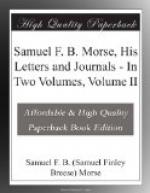“We entered the door of one of the towers and came immediately into the nave of the church. The effect of the long aisles and towering, clustered pillars and richly carved screens of a Gothic church upon the imagination can scarcely be described—the emotion is that of awe.
“A short procession was quickly passing up the steps of the choir, consisting of the beadle, or some such officer, with his wand of office, followed by ten boys in white surplices. Behind these were the prebendaries and other officers of the church; one thin and pale, another portly and round, with powdered hair and sleepy, dull, heavy expression of face, much like the face that Hogarth has chosen for the ’Preacher to his Sleepy Congregation.’ This personage we afterward heard was Lord Nelson, the brother of the celebrated Nelson and the heir to his title.
“The service was read in a hurried and commonplace manner to about thirty individuals, most of whom seemed to be the necessary assistants at the ceremonies. The effect of the voices in the responses and the chanting of the boys, reverberating through the aisles and arches and recesses of the church, was peculiarly imposing, but, when the great organ struck in, the emotion of grandeur was carried to its height,—I say nothing of devotion. I did not pretend on this occasion to join in it; I own that my thoughts as well as my eyes were roaming to other objects, and gathering around me the thousand recollections of scenic splendor, of terror, of bigotry, and superstition which were acted in sight of the very walls by which I was surrounded. Here the murder of Thomas a Becket was perpetrated; there was his miracle-working shrine, visited by pilgrims from all parts of Christendom, and enriched with the most costly jewels that the wealth of princes could purchase and lavish upon it; the very steps, worn into deep cavities by the knees of the devotees as they approached the shrine, were ascended by us. There stood the tomb of Henry IV and his queen; and here was the tomb of Edward, the Black Prince, with a bronze figure of the prince, richly embossed and enamelled, reclining upon the top, and over the canopy were suspended the surcoat and casque, the gloves of mail and shield, with which he was accoutred when he fought the famous battle of Crecy. There also stood the marble chair in which the Saxon kings were crowned, and in which, with the natural desire that all seemed to have in such cases, I could not avoid seating myself. From this chair, placed at one end of the nave, is seen to best advantage the length of the church, five hundred feet in extent.
“After the service I visited more at leisure the tombs and other curiosities of the church. The precise spot on which Archbishop Becket was murdered is shown, but the spot on which his head fell on the pavement was cut out as a relic and sent to Rome, and the place filled in with a fresh piece of stone, about five inches square....




